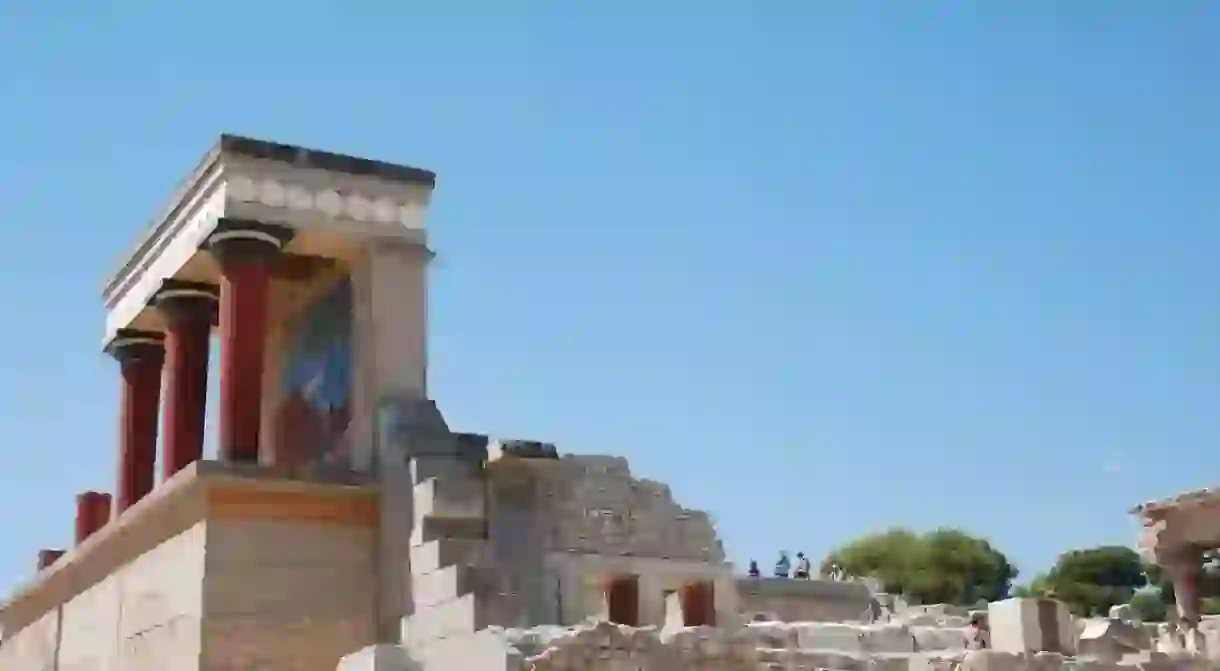A Brief Look at Knossos' 9,000-Year History

One of the many highlights of Crete is the ancient Minoan Palace of Knossos, located south of Heraklion. Occupied for the first time during the Neolithic period, around 7000 BC, Knossos – uncovered by English archaeologist Sir Arthur Evans – is the oldest site of the sort in Crete. Learn more about this rich vestige of ancient times.
There are plenty of myths surrounding the ancient city, including one about King Minos, who hired an Athenian architect by the name of Daedalus (Dedalos) to design his palace. Daedalus rose to the task and built it so cleverly that it was impossible for anyone at the palace to find their way back out without a guide.

Other stories state that the labyrinth was built to hold the Minotaur, a half-man, half-bull creature. King Minos then imprisoned the architect and his son to prevent them from revealing the plan to anyone. But Daedalus constructed sets of wings so that they could escape, which they did. But young Ikaros, Daedalus’ son, flew too close to the sun, which melted his wings, causing his tragic demise.
The other myth is that the Minotaur, who was living in the labyrinth, survived on a diet of human sacrifices, which King Minos requested from Athens. Every nine years, Athens would send seven young girls and boys to be sacrificed. It was during this time when Theseus, the son of the Aegean ruler of Attica, travelled to Crete and killed the monster, with the help of Ariadne, King Minos’ daughter.

Evidence shows that sometime between 3300 and 2000 BC, Knossos was a prosperous village, along with other sites such as Phaistos and Mallia. Experts place the period of the ‘first palaces’ at roughly between 2000 and 1700 BC; however, few remains exist as the ‘new’ palaces of the Neopalatial period (1700–1400 BC) were built over them. It was a time when cities were organised around the palaces – a time when religious, political and commercial powers were all concentrated. The palaces were larger than before, utilising better construction, architectural skills and innovation. With the use of different materials such as gypsum, the new palaces were more aesthetically beautiful than the previous ones and featured magnificent murals still visible today.
At that time, Knossos was undoubtedly the largest palace on the island, covering a surface of about two hectares and featuring two large wings: the west wing (storage for large jars containing oil, wine and cereals) and the east wing (where the royal apartments were). The city was spread all around the palace on 75 hectares.

By 1450 BC, however, the palace suffered considerable damage. Scientists have speculated that the main cause of the destruction of Knossos was the terrible volcanic eruption on the nearby island of Thera (now Santorini), which took place around 1620 BC, but it seems that Knossos survived despite everything.
Between 1450–1370 BC, the palace entered what is called the ‘Creto-Mycenaean’ era, marked by the influence of the Mycenaean civilisation. With other Minoan cities destroyed, Knossos was able to exercise dominion over the rest of the island; however, the palace was destroyed around 1370 BC. Some historians have suggested that its demise was caused either by fire, an earthquake or a revolt against the Mycenaean authorities. All that is certain is that the palace gradually fell into ruin and sank into oblivion.














